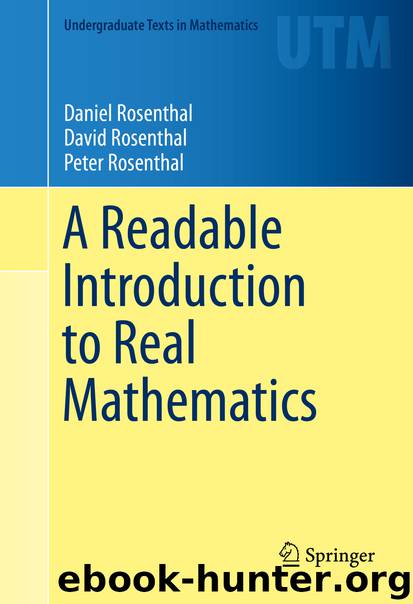A Readable Introduction to Real Mathematics by Daniel Rosenthal David Rosenthal & Peter Rosenthal

Author:Daniel Rosenthal, David Rosenthal & Peter Rosenthal
Language: eng
Format: epub
Publisher: Springer International Publishing, Cham
Roots of other complex numbers can also be computed.
Example 9.2.12.
All of the solutions of the equation can be found as follows. First note that and the argument of 1 + i is . That is, . Suppose that and . Then . Therefore , so , and 3θ is or or . Therefore, θ itself can be , , or . This gives the three solutions of the equation : , , and .
9.3 The Fundamental Theorem of Algebra
One reason for introducing complex numbers was to provide a root for the polynomial x 2 + 1. There are many other polynomials that do not have any real roots. For example, if p(x) is any polynomial, then the polynomial obtained by writing out has no real roots, since its value is at least 1 for every value of x.
Does every such polynomial have a complex root? More generally, does every polynomial have a complex root? There is a trivial sense in which the answer to this question is “no,” since constant polynomials other than 0 clearly do not have any roots of any kind. For other polynomials, the answer is not so simple. It is a remarkable and very useful fact that every non-constant polynomial with real coefficients, or even with complex coefficients, has a complex root.
The Fundamental Theorem of Algebra 9.3.1.
Every non-constant polynomial with complex coefficients has a complex root.
Download
This site does not store any files on its server. We only index and link to content provided by other sites. Please contact the content providers to delete copyright contents if any and email us, we'll remove relevant links or contents immediately.
| Algebra | Calculus |
| Combinatorics | Discrete Mathematics |
| Finite Mathematics | Fractals |
| Functional Analysis | Group Theory |
| Logic | Number Theory |
| Set Theory |
Modelling of Convective Heat and Mass Transfer in Rotating Flows by Igor V. Shevchuk(6408)
Weapons of Math Destruction by Cathy O'Neil(6220)
Factfulness: Ten Reasons We're Wrong About the World – and Why Things Are Better Than You Think by Hans Rosling(4715)
A Mind For Numbers: How to Excel at Math and Science (Even If You Flunked Algebra) by Barbara Oakley(3262)
Descartes' Error by Antonio Damasio(3250)
Factfulness_Ten Reasons We're Wrong About the World_and Why Things Are Better Than You Think by Hans Rosling(3218)
TCP IP by Todd Lammle(3158)
Fooled by Randomness: The Hidden Role of Chance in Life and in the Markets by Nassim Nicholas Taleb(3083)
Applied Predictive Modeling by Max Kuhn & Kjell Johnson(3043)
The Tyranny of Metrics by Jerry Z. Muller(3032)
The Book of Numbers by Peter Bentley(2935)
The Great Unknown by Marcus du Sautoy(2664)
Once Upon an Algorithm by Martin Erwig(2625)
Easy Algebra Step-by-Step by Sandra Luna McCune(2606)
Lady Luck by Kristen Ashley(2556)
Police Exams Prep 2018-2019 by Kaplan Test Prep(2517)
Practical Guide To Principal Component Methods in R (Multivariate Analysis Book 2) by Alboukadel Kassambara(2515)
All Things Reconsidered by Bill Thompson III(2374)
Linear Time-Invariant Systems, Behaviors and Modules by Ulrich Oberst & Martin Scheicher & Ingrid Scheicher(2348)
